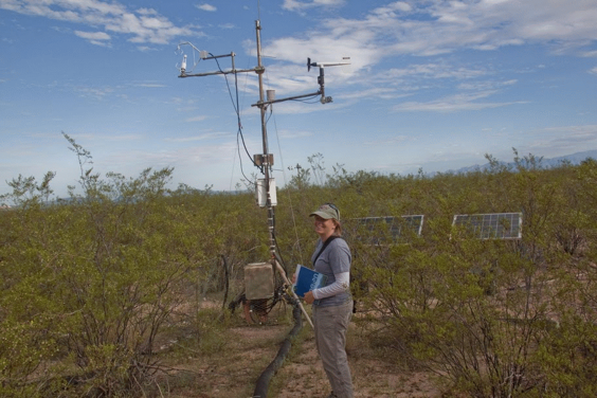 Dr. Papuga at the Creosotebush Flux Tower Site in the Santa Rita Experimental Range, AZ
Dr. Papuga at the Creosotebush Flux Tower Site in the Santa Rita Experimental Range, AZ Dr. Shirley Papuga is currently an Associate Professor in the Department of Geology at Wayne State University - Detroit, MI. She is also the current Chair of the AGU Ecohydrology Technical Committee. @MIhappyfamily | hydro.wayne.edu
What does ecohydrology mean to you?
In the most general sense, ecohydrology to me involves the way in which plants influence hydrologic processes, and in turn, how hydrology influences plant dynamics. In my view this could happen at multiple time (e.g. daily, annually) and space scale (e.g. stomata, catchments).
What are your undergraduate and graduate degrees in?
My undergraduate degree is in Mathematics from Kalamazoo College in Michigan. My PhD is from University of Colorado in the Geological Sciences.
How did you arrive at working in/thinking about ecohydrology?
When I started out my academic career, ecohydrology was really just gaining momentum as a new interdisciplinary science. I was lucky enough to have encountered some big thinkers throughout my graduate career who pushed me to look at the world with a curious interdisciplinary perspective.
As an undergraduate, I wanted to use my mathematics education in environmental science applications, and worked on a Senior Individualized Project “Hillslope Runoff Through Grids of Patchy Vegetation: Predictions Using Modified Percolation Theory” at Los Alamos National Laboratory (in 1997!). Through that project I was lucky enough to have the opportunity to work closely with two of today’s most influential ecohydrologists – Dr. Dave Breshears (ecologist), now at University of Arizona and Dr. Brad Wilcox (hydrologist) now at University of Texas A&M. Even then, Breshears and Wilcox were dabbling at bringing together ecologic and hydrologic perspectives!
Inspired by this, I decided to pursue a graduate education at University of Virginia (UVA), where under the mentorship of Dr. John Albertson I was exposed to eddy covariance and remote sensing techniques. Through in-person visits, John introduced our UVA cohort (including Kelly Caylor, Todd Scanlon, and Chris Williams) to big interdisciplinary thinkers like Ignacio Rodriguez-Iturbe and William Kustas. They helped me to see the importance of scale and how the land surface was connected to the atmosphere through the vegetation.
My time at UVA left me wanting a better hands-on understanding of what I had been modeling. So, I ventured off to New Mexico Tech to work with Dr. Eric Small (now at University of Colorado) – where I began to work in the field at the Sevilleta desert grasslands and shrublands with Bowen ratio, eddy covariance, and sap flow systems - giving me a keen appreciation for the challenges of collecting data. Eric also had a partnership with University of Arizona which gave me the opportunity to interact with more field-oriented interdisciplinary hydrologists like Paul Brooks and Russ Scott. I also attended the AGU Chapman conference “Eco-hydrology of Semiarid Landscapes: Interactions and Processes” held in Taos, New Mexico. That small formative conference gave me the opportunity to meet and brainstorm with more of our big interdisciplinary thinkers like Rob Jackson and Travis Huxman. And it was from there that I was really committed to dryland ecohydrology.
The bottom line for me is that as a student I was encouraged to talk with people from different disciplines and different perspectives. Those discussions shaped the way I think about problems. Over time, ecohydrology became the intuitive way for me to think about the interconnected processes on the land surface and their feedbacks with the atmosphere.
What do you see as an important emerging area of ecohydrology?
I think we are going to see the potential for ecohydrology in helping us in understand the dynamics of contaminant transport and pervasiveness in complex systems such as cities.
Do you have a favorite ecohydrology paper? Describe/explain.
My favorite ecohydrology paper is “Ecohydrology: A hydrologic perspective of climate‐soil‐vegetation dynamics” by Ignacio Rodriguez-Iturbe published in Water Resources Research in 2000. This “vision paper” emphasizes the role of soil moisture in connecting the vegetation to the atmosphere and also to biogeochemical processes. I also feel that it came at a time when I was one of those “young researchers” that was looking for the sort of encouragement that Dr. Rodriguez-Iturbe was bestowing.
What do you do for fun (apart from ecohydrology)?
I have to admit, I have a super family that is a whole lot of fun. They’re my boys – my husband, our two sons (5 and 2), and our dog. We have fun doing everything together – from digging for worms in the yard, wearing noise-cancelling headphones at the Detroit Grand Prix, camping in the rain, riding the streetcar, growing giant carrots in our stock tank garden, watching Paw Patrol, and playing soccer. Those boys make every moment amazing!
 RSS Feed
RSS Feed